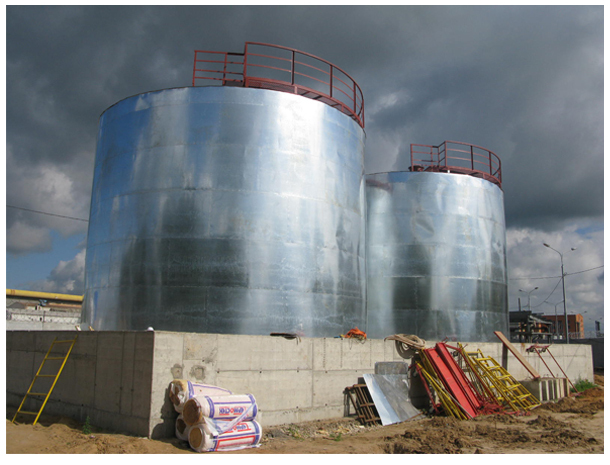Accumulator tanks (BAGV) are used to accumulate heat during interruptions in the operation of the boiler plant. As a rule, such a unit is installed in schemes with solid fuel boilers (TT). Much less often it is used to service solar collectors and typical electric heaters.
BAGV device
Structurally, a storage tank for hot water is a tank in the form of a cylinder or a regular square. Several nozzles are cut into its body, the number of which depends on the characteristics of the heating system. The latter means the number of circuits and heating devices provided for in it.
The demanded volume of the tank depends on the heated area (it is chosen in the range from 200 to 3 thous. m³). To save heat for a long time, the tank is sheathed with a layer of heat insulator with a thickness of 5 to 10 cm.
Depending on the tank model, it includes the following units:
- Heat exchangers (there are several of them).
- Electric heater.
- Magnesium anode that protects the tank body from destruction.
Heat exchangers are manufactured in the form of copper coils and are mainly used in two-circuit systems. Electric heaters allow you to maintain the desired temperature of the coolant during short interruptions in the operation of the boiler.
Purpose of BAGV, which gives its installation and operation
To understand the principle of operation and purpose of the BAGV, it is important to familiarize yourself with the following features of the unit's functioning:
- under normal conditions, the coolant is heated in the TT boiler and enters the batteries through the piping system;
- there it gradually cools down and returns to its starting point along the return;
- in the event of an emergency stop of the boiler, the coolant quickly cools down until the accident is eliminated and the next laying of firewood or pallets;
- the temperature in the room during this time has time to drop.
When integrated into the BAGV system, the problem with the coolant cooling is removed.
After starting the boiler TT, the coolant will begin to move along a limited circuit (between the BAGV and the heater). As it heats up, the latter gradually fills with liquid (photo on the right). As soon as the container is completely filled, the circulation pump turns on. With its help, the heated coolant is pumped into the heating system.
When the fuel burns out and before a new bookmark is made, the system operates at the expense of the heat accumulated in the BAGV. At the same time, the temperature in the rooms is always maintained at a comfortable level.

Correct installation of BAGV
According to the requirements of technical standards, the water accumulator tank is connected by branch pipes parallel to the boiler equipment. For these purposes, pipes of a certain diameter are suitable, into which control devices are built. The harness kit includes the following mandatory components:
- 3-way valve.
- Booster pump installed in the return line (between the boiler and BAGV).
- Protective devices.
- Heat exchanger for hot water.
- The valve is 3-way.
- Circulation pump (it is located between the tank and heating batteries).
At the initial stage, a flat concrete platform is prepared, after which the BAGV is placed on it strictly according to the level.
Important! The upper nozzles are located higher than the set of heating elements.

This arrangement guarantees natural circulation in the system in the event of a pump breakdown.
Then the piping from the boiler is connected to the upper branch pipe. On the other hand, the nearest radiator section is connected to the BAGV. In the supply branch, a security group is mounted, consisting of the following devices:
- Typical pressure gauge.
- Special safety valve.
- A valve designed to bleed air.
Upon completion of these operations, a 3-way valve is installed to protect the equipment from excess condensate. A circulation pump is mounted in front of it, through which heated water is pumped into the storage.
The lower branch pipe from the batteries is connected to the return line, and on the other side to the boiler equipment. Special plugs are screwed on all unused pipes. At the final stage of work, the electrical equipment of the system is connected to the 220/380 Volt network.
Upon completion of the installation, they proceed to a test check of the functioning of the system, to which specialists should be invited. The invited masters will help to adjust the work of all structural units and check them for operability.
Conclusion
In modern conditions production of containers and tanks for storage of hot water it was supplied on an industrial basis. For an ordinary consumer, it will not be difficult to acquire the desired model for a certain amount. The main thing is to understand the BAGV device and the correct installation techniques for the purchased equipment.
